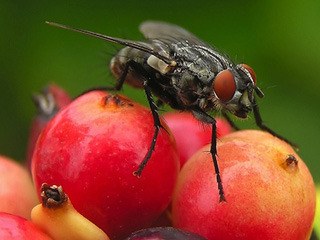There are thousands of different fly species but only a few that are considered pests around the home.
Aside from their obvious annoying behaviors, their breeding grounds are places that contain bacteria and viruses that can cause human diseases. Humans are most bothered by flies in the adult flying stage; however, controlling them is best achieved during the larva stage.
By identifying the species and understanding the entire lifecycle of the pests, you can make better decisions on which control measures to take.
The lifecycle begins with the female adult fly that deposits eggs in things such as feces, carrion and organic materials. She will select places that are moist and large enough for the eggs to grow into maggot-like larvae. The surroundings will provide the bacteria needed for the larva to grow and complete the metamorphosis. Their skin from the last larval stage will harden to create a puparium in which the pupa will develop and an adult fly will emerge from. After mating, the female can lay hundreds of eggs in batches. The total lifecycle generally takes about 7 to 10 days.
• House fly – Found in greater numbers during the hot summer months, the house fly is bothersome as it lands on food for human consumption and worrisome because it also favors manure and other unsanitary sources of bacteria and viruses, causing health hazards such as cholera, diarrhea, dysentery, food poisoning, eye infections and yaws.
House flies are less than 3/8-inch in length with four darker stripes down the thorax and have sponging mouth parts that use saliva and regurgitation to liquefy solid foods for consumption.
• Stable fly – Found in neighborhoods with larger populations of livestock, these pests are more severe in the beginning of summer with numbers tapering off thereafter.
Stable flies have a sword-like mouth and use that dagger to feed on the blood of animals and humans. Also differing from the common house fly, the stable fly lacks the four darker stripes and has a longer lifecycle of about 12 days.
• Blow fly – A group of fly species noted for their shiny metallic-like green, blue and copper colorations are summed up and referred to here as blow flies.
These pests prefer dead animals in which to deposit their eggs but are generally found in urban environments where they favor food waste and pet feces.
All nuisance fly species are best controlled by concentrating on removing attractants to adult flies and reducing areas of larval development:
• Place garbage containers away from buildings
• Keep garbage receptacles sanitized and free of build-up
• Weather-tighten buildings with caulking to prevent entry of flies
• Use screening at all points of entry (doors, windows, bird blocks, venting, etc.)
• Locate compost piles away from buildings and stir them once or twice a week to keep them “hot”
• Grind/chop compostable materials down to small pieces
• Constantly remove and dispose of pet feces
• Maintain livestock quarters by removing and composting manure at least twice a week
• Cover organic food scraps in the compost pile
• Immediately remove and properly dispose of unharvested fruits and vegetables
Other controls
Food traps can help, however, they smell bad and should be placed away from buildings. Light traps work in areas without sunlight. Fly tape is effective for some species of flies. Electric bug zappers will work but explode the insects into pieces and should not be used in areas of food or food preparation.
Get out the old flyswatter; they still work great, but again, be cautious when using around human food.
Chemical controls are rarely needed in residential applications as tolerance levels can be maintained through sanitization and mechanical control methods. If sanitation cannot be achieved, a non-residual pyrethrin spray can be used. Or contact a professional pest control company for residual applications involving outside walls and overhangs where flies accumulate. There are insect repellents containing permethrin or pyrethrin that can be effective to relieve your pets from the nuisance of flies; consult your vet for treatment.
Michele Mangiantini is a Washington State University-certified, Clallam County Master Gardener.


